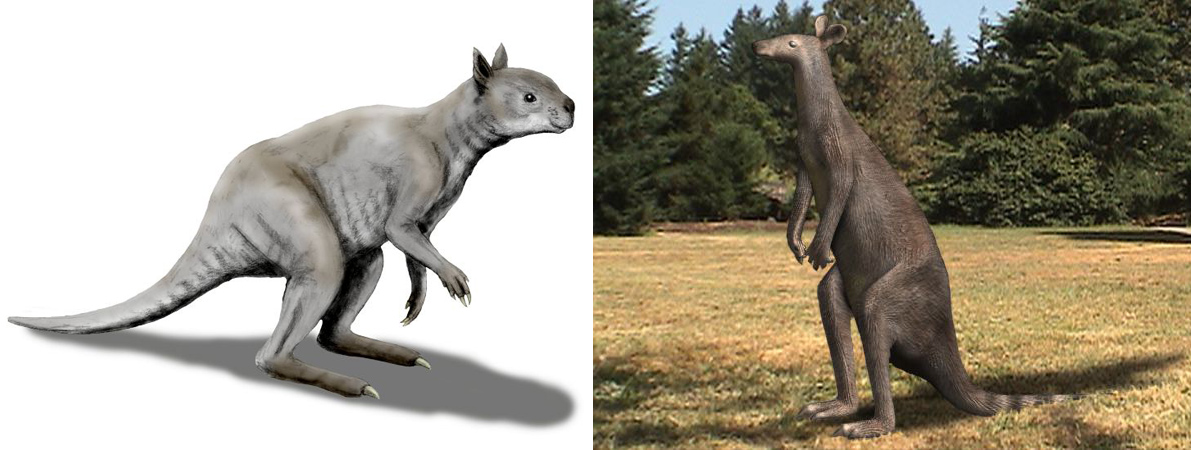It looks like you're using an Ad Blocker.
Please white-list or disable AboveTopSecret.com in your ad-blocking tool.
Thank you.
Some features of ATS will be disabled while you continue to use an ad-blocker.
5
share:
Using bones collected from a Tasmanian cave, researchers from the University of Adelaide's Australian Centre for Ancient DNA were able to extract DNA
from two extinct marsupials. The DNA was taken from the remains of two specimens: a giant short-faced kangaroo (Simosthenurus occidentalis) and a
giant wallaby (Protemnodon anak).
 Left: Simosthenurus occidentalis Right: Protemnodon anak Credit: Wikimedia Commons
Left: Simosthenurus occidentalis Right: Protemnodon anak Credit: Wikimedia Commons
The skeletal remains were radiocarbon dated to about 45,000 years-old and the team credits the cool, dry conditions of the cave with preserving the genetic material within the bones. Those hoping to see resurrected specimens of these two mega marsupials will be sorely disappointed as only short segments of mtDNA were recovered. Those short segments were enough, however, to sequence a partial mtDNA genome which provides invaluable information about the evolutionary relationships of marsupials.
From Science Daily:
So how big were these extinct species? This species of giant wallaby is thought to have tipped the scales at about 240 lb (~110 kg) and the giant short-faced kangaroo is believed to have been twice its size at over 500 lb (~225 kg) — about three times as large as modern kangaroos! In related news, a paper published in PLOS ONE this past October detailed research of the anatomy of another giant kangaroo species, Procoptodon goliah, which indicates that unlike the extant species, the extinct giant kangaroos were walkers and not hoppers.
There are two additional sources at Obscuragator.

The skeletal remains were radiocarbon dated to about 45,000 years-old and the team credits the cool, dry conditions of the cave with preserving the genetic material within the bones. Those hoping to see resurrected specimens of these two mega marsupials will be sorely disappointed as only short segments of mtDNA were recovered. Those short segments were enough, however, to sequence a partial mtDNA genome which provides invaluable information about the evolutionary relationships of marsupials.
From Science Daily:
"The ancient DNA reveals that extinct giant wallabies are very close relatives of large living kangaroos, such as the red and western grey kangaroos," says lead author Dr Bastien Llamas, ACAD senior research associate. "Their skeletons had suggested they were quite primitive macropods─a group that includes kangaroos, wallabies, pademelons and quokkas─but now we can place giant wallaby much higher up the kangaroo family tree."
Although ancient DNA confirms that the short-faced kangaroos left no descendants, it also shows their closest living cousin could be the banded hare-wallaby (Lagostrophus fasciatus), which is now restricted to small isolated islands off the coast of Western Australia.
So how big were these extinct species? This species of giant wallaby is thought to have tipped the scales at about 240 lb (~110 kg) and the giant short-faced kangaroo is believed to have been twice its size at over 500 lb (~225 kg) — about three times as large as modern kangaroos! In related news, a paper published in PLOS ONE this past October detailed research of the anatomy of another giant kangaroo species, Procoptodon goliah, which indicates that unlike the extant species, the extinct giant kangaroos were walkers and not hoppers.
There are two additional sources at Obscuragator.
edit on 2015-1-16 by theantediluvian because: (no reason given)
A 500lb Kangaroo...Awesome.
I hope they knock one up in the lab.
I hope they knock one up in the lab.
That's some great stuff. The ancient kangaroos even appear at a lower resolution, kinda blocky.
Kangaroos have very few predators after the thylacine and marsupial lion went extinct. Sadly enough, the most feared predator of the kangaroo is us
and the dingo.
While we could certainly take down most large animals with the proper caliber, what would these animals natural predator be if they were introduced back into the wild?
They'll probably only be bred in captivity and end up in a zoo anyways.
While we could certainly take down most large animals with the proper caliber, what would these animals natural predator be if they were introduced back into the wild?
They'll probably only be bred in captivity and end up in a zoo anyways.
new topics
-
Elon Musk Calls for Tommy Robinson to be Freed - and Takes a Dig at Starmer
Politicians & People: 15 minutes ago -
Biden to award Presidential Citizens Medal to Liz Cheney and Bennie Thompson
US Political Madness: 44 minutes ago -
Just learned a really helpful trick for internet searches
Computer Help: 6 hours ago -
Not off to a good start
General Chit Chat: 8 hours ago
top topics
-
If they can see...they can read!!
Rant: 15 hours ago, 7 flags -
Just learned a really helpful trick for internet searches
Computer Help: 6 hours ago, 6 flags -
Not off to a good start
General Chit Chat: 8 hours ago, 5 flags -
Biden to award Presidential Citizens Medal to Liz Cheney and Bennie Thompson
US Political Madness: 44 minutes ago, 2 flags -
Elon Musk Calls for Tommy Robinson to be Freed - and Takes a Dig at Starmer
Politicians & People: 15 minutes ago, 1 flags
5
